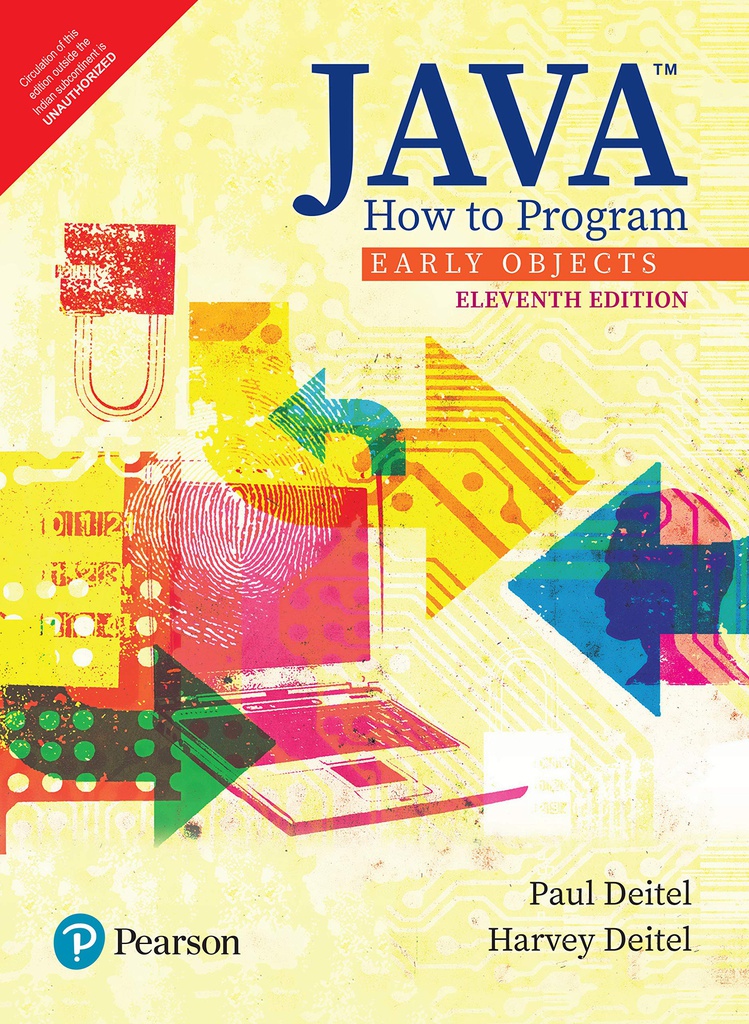Java How to Program: Early Objects, 11e
Java How to Program, Early Objects, 11th Edition, presents leading-edge computingtechnologies using Deitels’ signature live-code approach, which demonstratesconcepts in hundreds of complete working programs. The ground-breaking How toProgram series offers unparalleled breadth and depth of programming fundamentals,object-oriented programming concepts and intermediate-level topics for furtherstudy. This edition presents Updated coverage of Java SE 8 and New Java SE 9capabilities, including JShell, the Java Module System and other key Java 9 topics.
Table of Contents
Rich coverage of programmingfundamentals; real-world examples:
- Interactive Java through JShell–Java SE 9’s most exciting New pedagogic feature
- Lambdas, sequential and parallel streams, functional interfaces
- JavaFX GUI, 2D and 3D graphics, animation and video
- Composition vs. Inheritance, dynamic composition
- programming to an interface not an implementation
- Files, input/output streams and XML serialization
- Concurrency for optimal multi-core performance
- Other topics: recursion, searching, sorting, generics, data structures, optional Swing GUI, multithreading, database (JDBC TM and JPA
Outstanding applied pedagogy to facilitate learning:
- Programming Wisdom: Hundreds of valuable programming tips facilitate learning. Icons throughout the text identify Software Engineering Observations, Good Programming Practices, Common Programming Errors,Error-Prevention Tips, Portability Tips, Performance Tips and Look-and-Feel Observations (for GUI design).
- Hundreds of self-review exercises with answers.
- Hundreds of interesting real-world exercises and projects enable students to apply what they've learned.
- “Making a Difference” exercises encourage students to use computers and the Internet to research andaddress significant social problems. 1. Introduction to Computers, the Internet and Java 2. Introduction to Java Applications; Input/Output and Operators
Introduction to Classes, Objects, Methods and Strings
Control Statements: Part 1; Assignment, ++ and -- Operators
Control Statements: Part 2; Logical Operators
Methods: A Deeper Look
Arrays and Array Lists
Classes and Objects: A Deeper Look
Object-Oriented Programming: Inheritance
Object-Oriented Programming: Polymorphism and Intefaces
Exception Handling: A Deeper Look
JavaFX Graphical User Interfaces: Part 1
JavaFX GUI: Part 2
Strings, Characters and Regular Expressions
Files, Input/Output Streams, NIO and XML Serialization
Generic Collections
Lambdas and Streams
Recursion
Searching, Sorting and Big O
Generic Classes and Methods: A Deeper Look
Custom Generic Data Structures
JavaFX Graphics and Multimedia
Concurrency
Accessing Databases with JDBC
Introduction to JShell: Java 9’s REPLA. Operator Precedence ChartB. ASCII Character Set C. Keywords and Reserved Words D. Primitive Types E. Using the Debugger Online Chapters and Appendices
Swing GUI Components: Part 1
Graphics and Java 2D
Networking
Java Persistence API (JPA)
Java Server Faces Web Apps: Part 1
Java Server Faces Web Apps: Part 2
Rest-Based Web Services
(Optional) ATM Case Study, Part 1: Object-Oriented Design with the UML
(Optional) ATM Case Study, Part 2: Implementing an Object-Oriented Design
Swing GUI Components: Part 2
Java Module System and Other Java 9
Features:
- Using the Java API Documentation
- Creating Documentation with Javadoc
- Unicode
- Formatted Output
- Number Systems
- Bit Manipulation
- Labeled break and continue Statements
- UML 2: Additional Diagram Types
- Design Patterns.
| Book | |
|---|---|
| Author | Deitel |
| Pages | 1288 |
| Year | 2018 |
| ISBN | 9789353062033 |
| Publisher | Pearson |
| Language | English |
| Uncategorized | |
| Edition | 11/e |
| Weight | 1.52 kg |
| Dimensions | 24.4 x 20.3 x 3.7 cm |
| Binding | Paperback |


